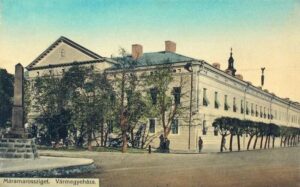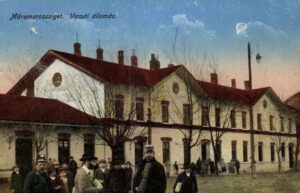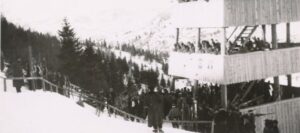Vila Groedl din Sighetu Marmației
🇷🇴 Vila Groedl din Sighetu Marmației fost construită în anul 1887 de către baronul Hermann Armin Freiherr Groedl von Gyulafalva und Bogdán. Familia acestuia a dominat economic Maramureşul între anii 1870-1940, construind gara Sighetului, noua moară de sare, fabricile de cherestea, mobilă şi perii de aici şi au deținut zeci de mii de hectare de păduri.
Vila a devenit sediu al Armatei a 7-a germane în Primul Război, apoi, printre altele, sălaş al contrabandistului Piticu din romanul “Apa” de Alexandru Ivasiuc (imediat după cel de-al Doilea Război). Aceasta a fost naţionalizată de către comunişti şi transformată în azil de bătrâni, suferind două incendii în ultimele decenii ale secolului XX şi pierzându-şi mult din caracter.
Și-a mai pierdut unul din cele două foişoare de poartă, porţile propriu-zise, gardul de fier forjat, parcul cu statui, bazine de apă şi arbori exotici şi toate interioarele – cu mobilier stil şi multe obiecte de artă.
🇭🇺 A máramarosszigeti Groedl villát 1887-ben Hermann Armin Freiherr Groedl von Gyulafalva und Bogdán építette. Családja 1870-1940 között gazdasági szempontból uralta Máramaros vármegyét. Ő építette a máramarosszigeti pályaudvart, az új sómalmot, a faipari üzemeket, bútorgyárat és több tízezer hektár erdőt birtokoltak.
A villa az első világháborúban a 7. német hadsereg központja lett, majd többek között a Piticu csempész rezidenciája lett, Alexandru Ivasiuc “Apa” regényéből (közvetlenül a második világháború után). A kommunisták államosították és idősek otthonává alakították, a huszadik század utolsó évtizedeiben két tüzvészt vészelt át és jellege nagy részét elvesztette.
Eltűnt két kapu boltozatának egyikét, magukat a kapukat, a kovácsoltvas kerítést, a parkot szobrokkal, vízi medencékkel és egzotikus fákkal, valamint az összes belső teret – stílusos bútorokkal és sok művészeti tárggyal.
🏴 The Groedl villa from Sighetu Marmatiei was built in 1887 by baron Hermann Armin Freiherr Groedl von Gyulafalva und Bogdan, who’s family name dominated the economy of Maramures between 1870 to 1940, building the Sighet railway, the new salt mine, the timber, furniture and brushes factories and owning tens of thousands of hectares of forest.
The vila became the headquarters of the 7th German Army in the First World War, and then, among others, it was the shelter of the Piticu smuggler from the Apa novel, written by Alexandru Ivasiuc (right after the end of WW2); it was nationalised by the communists and transformed into an old care facility. Unfortunately, a lot of its character was lost due to the fact that the villa suffered 2 fires.
It lost one of its 2 gate arches, the main gates, the wrought iron fence, the statue park, the water basins, the exotic trees and all of its interior – with all the furniture and art pieces.
📸 bedo.hu – text Teofil Ivanciuc








